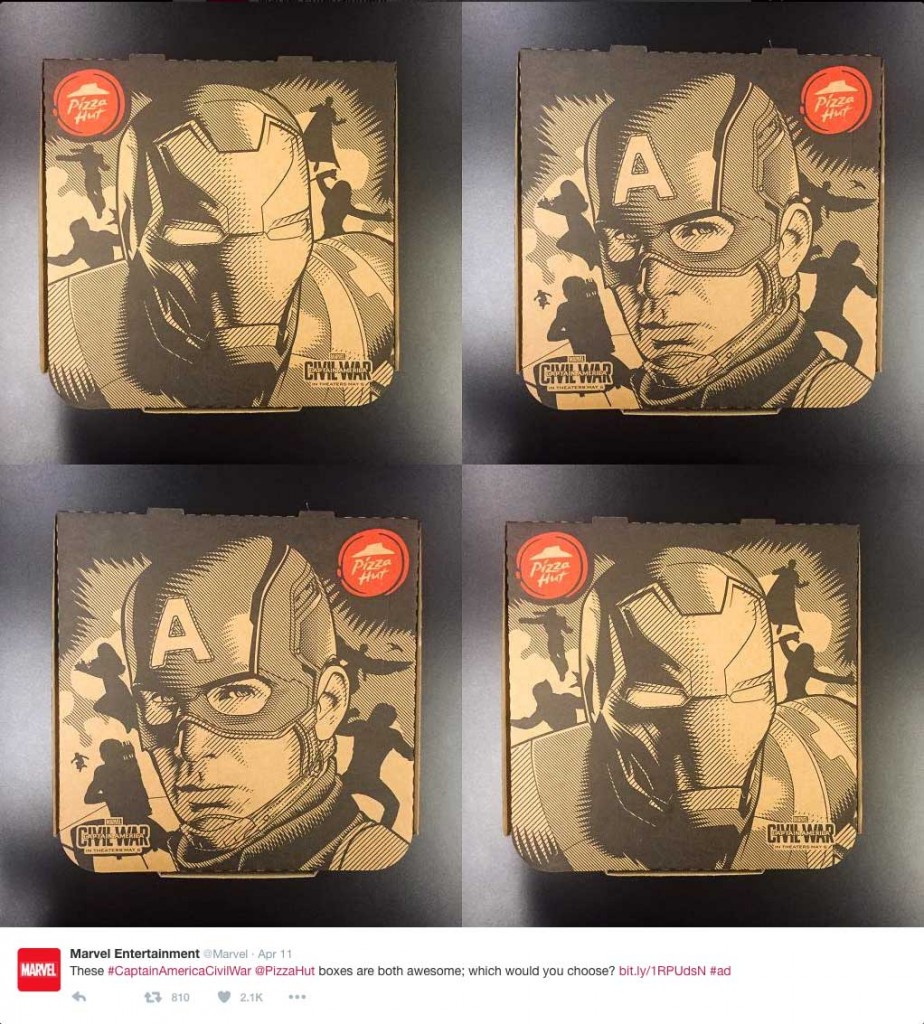
Its characters may be fighting onscreen, but Captain America: Civil War is a product of collaboration. In the days leading up to the release of the film, Marvel revealed that they had spent $200 million on promotional tie-ins (which, let’s be honest, isn’t unheard of these days—check out our roundup of Anchorman 2’s ridiculous-in-the-best-way publicity). From Harley-Davidson to Pizza Hut, over 100 companies worldwide participated in the Civil War marketing blitz, making it one of the biggest co-branding campaigns in recent memory.
Between the Marvel Universe and Star Wars, Disney owns two of the most bankable properties in media and entertainment, and the conglomerate isn’t afraid to spend the equivalent of Palau’s annual GDP on merchandising.
But you don’t need millions of dollars, multiple theme parks, and controlling interest in Robert Downey Jr’s soul to successfully launch a co-branding effort. Small and medium-sized brands can—and should—collaborate to bring cool ideas to life and deepen their engagement with fans and consumers.
No matter your size, timeline, intention, or number of partners, it takes three ingredients to make a co-branding campaign work:
Exclusive Benefits
The Portland Trail Blazers may not have the largest stadium or fan base in the NBA, but that hasn’t stopped the team from innovating through collaborations with regional companies and startups. The Blazers have tapped into Oregon’s thriving tech community to enrich fans’ experiences before, during, and after the game. With invisible barcodes and peer-to-peer parking, the team can give its supporters the benefits of cutting-edge technology while providing the emerging companies behind that technology with exposure to a wider audience.
Purpose, Purpose, Purpose
Remember the Ben & Jerry’s/New Belgium collaboration we blogged about back in January? The reason that campaign caught our attention was because it beautifully demonstrated the necessity of purposeful teamwork. Now, that may sound simple, but let’s break it down—I’m not just referring to “purpose” in one sense:
- As B Corps, the two companies share a larger, overall purpose: positive social and environmental impact.
- By touting the companies’ shared values and building buzz around B Corps, the strategy had a marketing purpose—it was the right way to promote the mission.
- Because Ben & Jerry’s and New Belgium appeal to many of the same consumers, and each company’s flavors translate well to the other’s products, the partnership simply made sense—it was a purposeful collaboration, rather than an arbitrary one.
Target’s partnership with UNICEF is another great recent example of this principle in action. Last October, around the same time of year when kids in the U.S. traditionally go door-to-door to collect UNICEF donations, the charity and the retailer teamed up to develop the Kid Power Band: a fitness wearable that interfaces with a proprietary app. Kids can accomplish “missions” to earn points and “unlock” food for underserved, malnourished communities around the world. As a co-branding campaign, it works by harnessing existing consumer behavior and awareness and repackaging it into a gamified form at once familiar and fun.
Strategic and Demographic Utility
While not a co-branding campaign by strict definition, Michelin Guides exemplify the long-term rewards a company gains through experimentation and collaboration outside of that company’s primary industry.
Published in 1900, the first Michelin Guide was a free publication meant to sell cars. It listed hotels and gas stations, and included maps and vehicle repair instructions. Over the years, as the publication grew in circulation, it expanded into different territories and began to encompass a greater scope of information for tourists. The guides soon catalogued restaurants, and eventually, awarded those restaurants with stars. As dining establishments competed for more stars, Michelin Guides rose in prominence. Thus, what started as promotional giveaway material for a tire company evolved into one of the most influential critical references on food.
Why? Because, as it turns out, everyone needed Michelin Guides. Michelin needed a tactic that would reliably build a customer base. Drivers (there were fewer than 3,000 in France at the time) needed information about what was out there on the road. Restaurants needed endorsement from an independent authority that would set them apart. And these days, destination marketing organizations, many of which have partnered with Michelin to create city- or country-specific guides, rely on Michelin’s name brand recognition to drive tourism rates.
In each of the examples above, brands were able to branch out into new product areas and initiatives by working together. But the results didn’t happen at random: co-branding needs to be useful—and it needs to make sense—for all involved.
Beyond that, the possibilities are endless. I hope you’re motivated to try something new!
